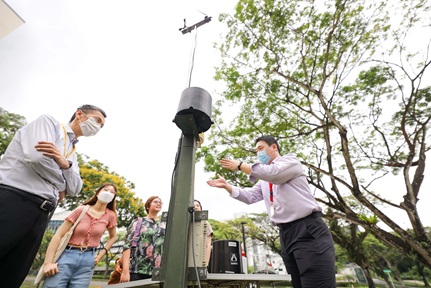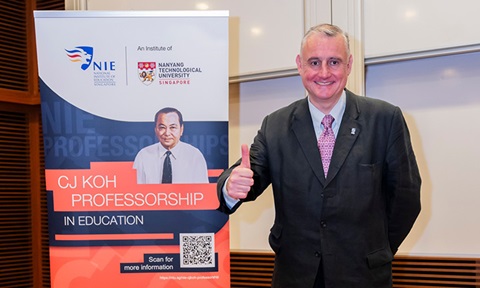Gifted with learning disabilities: ‘A’ for IGCSE at 10, but struggles in primary school
SINGAPORE – Eleven-year-old Mohamed Mikail Mohamed Shahrom is way ahead of his peers in terms of his science knowledge, but finds it difficult to cope in primary school.
In October 2023, Mikail sat the International General Certificate of Secondary Education (IGCSE) combined science examination, which is similar to the GCE O levels, and scored 87, or an A.
This was despite having less than two months to prepare for the exam, which assesses physics, chemistry and biology concepts. It is usually taken by students from international schools.
But Mikail, who is in Primary 6, struggles in school as he has multiple special educational needs (SEN), including dyslexia and dysgraphia.
Dyslexia is a learning difficulty that affects reading and spelling, while dysgraphia is a neurological condition where a child has difficulty turning his thoughts into written words.
Mikail is among a group of children who are known as Twice-Exceptional (2E) learners, who are both gifted and have a learning disability.
The boy, who has three younger siblings, has been devouring information on topics such as astrophysics, the immune system and the history of penicillin since he was young.
With his deep knowledge of science, Mikail says he is sometimes bored in school, and likes only recess and his co-curricular activity, which is sailing.
He does not do well when it comes to homework and tests which involve writing, says his mother Yvonne Neo, 41, a former secondary school science teacher.
“With dysgraphia, he has trouble writing down what he thinks. With dyslexia, he gets the words jumbled up,” says Madam Neo, who describes his handwriting as erratic and disorganised with multiple cancellations.
He is not part of his school’s elite science programme E2K.
In a bid to keep him engaged in learning, Madam Neo decided to sign him up for the IGCSE combined science exam, as mainstream students cannot sit the O levels in advance.
Mikail says he enjoyed preparing for the exam as “I learnt things I don’t know”.
Madam Neo says many programmes that can stretch him in science are inaccessible given his age and their budget.
“I understand why children can’t be accelerated beyond their age in school, but it greatly limits people like him because he may be held back until he loses interest.
“It isn’t easy to parent a 2E child, but neither is it easy being a 2E student with little success at exams in school because of his SEN,” adds Madam Neo, whose husband is a history teacher.
While there are no official figures in Singapore as to how many 2E children there are, an estimated 6 per cent of gifted children in the United States are 2E, according to the University of Iowa’s Belin-Blank Center, while a study conducted in Australian schools puts the figure at 2 to 7 per cent.
According to psychologists, giftedness in 2E children could come in the form of academic achievement, talent in music and the arts, or advanced problem solving, creative or reasoning abilities.
At the same time, these children have learning or developmental challenges, in areas like speech and language, emotional and behavioural, or sensory and physical disabilities.
Psychologist Natalie Lim, who is the head of clinical services at Dynamics Psychological Practice, says typical characteristics of 2E children include having a wide range of interests not related to school. The child performs well in complex or advanced tasks, but does relatively poorly in “basic” work.
These children may have poor social skills and difficulties with reading and writing due to cognitive processing deficits, she notes.
“They have advanced ideas and opinions expressed verbally, but not seen in written work. There may also be behavioural problems due to underlying stress, boredom and lack of motivation,” she adds.
Dr Wilson Chan, a principal educational psychologist from The Gifted Lab, which conducts psycho-educational assessments, says 2E learners may be misunderstood.
Parents and teachers may be frustrated at why a child with gifted characteristics is unable to do well academically, makes careless mistakes in mathematics and spelling, or has poor handwriting.
“They may assume that the child is unmotivated or defiant or has a poor attitude, and may implement strict corrective measures, thereby heightening the child’s academic-related frustration and school anxiety,” he says.
Bright but unfocused – it turned out to be ADHD
In primary and secondary school, Melina Leong was often distracted and did not pay attention in class.
Although she could focus for only short periods of time, the 17-year-old, who is now in the first year of junior college, picked up information fast and, with the help of tutors, she was able to cope in school.
She has also been performing with the Singapore Symphony Children’s Choir since she was 10 and recently scored a distinction for her Grade 8 piano exam.
She did not suspect there was anything wrong until her friend sent her a video clip on traits of people with attention-deficit/hyperactivity disorder (ADHD) when she was in Secondary 3, joking that it sounded like her.
She realised that she indeed had many of the characteristics and read up on the topic.
When she asked her parents to take her to a doctor, they told her she did not have ADHD as she “never struggled in school”.
It took a year before her parents agreed to an assessment and she was diagnosed with the condition at age 16.
She finally understood why she was unmotivated, because ADHD affected her dopamine levels.
Her mother Chia Gin Gin, 45, a housewife, says Melina has a good memory and was able to absorb enough information to get by in school before her attention span ran out. But she takes three-hour naps after school.
“She compensates, but at a huge energy cost, so she gets very tired,” says Madam Chia, whose husband Douglas Leong, 56, is an in-house legal counsel.
Mr Leong also sits on the board of the charity Unlocking ADHD, which runs events and provides resources to support people with ADHD.
Melina, who has a younger brother, aged 14, adds: “I was not hyperactive in class, so my teachers just thought I was not concentrating.”
Experts say a common phenomenon which makes the identification of 2E learners challenging is that their giftedness and learning disability could mask each other.
Dr Adrian Loh, a senior consultant psychiatrist at private clinic Promises Healthcare, says it may apply more to girls as they are quieter.
“What we do know now is a lot of girls are being missed. They often compensate for their deficits with their abilities. So that’s where an awareness of twice-exceptionality is important,” he adds.
Ms Lois Lim, a principal educational psychologist at Firm Foundation Psychological Practice, which specialises in children’s learning, notes that a gifted child might use memory strategies to overcome initial reading difficulties.
In other cases, the learning disability might hide the giftedness – a gifted dyslexic child could look like an average student on literacy tasks.
Another challenge in identifying 2E learners could be the stigma attached to the SEN label, as they often need additional support, says Professor Kenneth Poon, dean of education research at the National Institute of Education.
But parents should understand that the diagnosis could help them gain knowledge about the challenges 2E learners face and they can then find the most effective approaches to support their child, he adds.
More support would help 2E learners thrive
Primary 4 pupil Syed Ali Alswij, 10, is eloquent, but when it comes to work that requires lengthy writing, he struggles as his hand hurts.
In 2023, he was diagnosed with severe dyspraxia, a developmental coordination disorder that affects motor skills.
Although dyspraxia does not affect intelligence, it can impact learning in a traditional classroom.
His mother, Dr Hana Alhadad, 46, a researcher, says his visual-spatial intelligence scores were high on the Wechsler Intelligence Scale for Children test he took, but processing speed scores were low.
He finds it difficult to understand arithmetic when verbal instructions are given, but has no issues with geometry.
“He translates instructions into a visual picture. But not everything can be translated so that’s when he gets confused,” says Dr Hana.
“During that process, it looks like he’s daydreaming, but he’s actually translating the auditory into visual,” she says.
She hopes there is leeway to type in exams rather than having to hand-write answers, as this would help Ali cope better.
A common thread among the 2E learners is that they may not thrive in school.
Ali, who has two younger siblings, says: “School is tiring. I have a lot of uncompleted work. Sometimes I don’t understand what the teacher is saying because I’m a slow learner.
“I hope there can be fewer worksheets. They give me a lot of pain.”
Mikail wishes his schoolmates did not know he excelled in science.
“I wish students are more aware of kids with differently abled brains and not make fun of us. They may not say anything, but will still laugh among themselves,” he adds.
Teachers may have to take the first step to recognise the strengths of these learners.
Dr Geetha Shantha Ram, director of specific learning differences assessment services at the Dyslexia Association of Singapore, did a qualitative study in 2022 on pre-school teachers who taught pupils who were potentially gifted and learning disabled.
She found that the teachers were focused on trying to fix the deficits of the children, with the giftedness used only to support the weaknesses.
“If adults are fixated on deficits, the children’s sense of self-worth will dip. By flipping the attention to strengths, we’re able to help the learner identify his true self-worth,” she says.
She hopes there can be more awareness of twice-exceptionality so that parents and teachers can provide more support for children.
“Positive external support is a huge factor in enabling them to overcome difficulties.”
Read the original article here.
Source: The Straits Times © SPH Media Limited. Permission required for reproduction.






